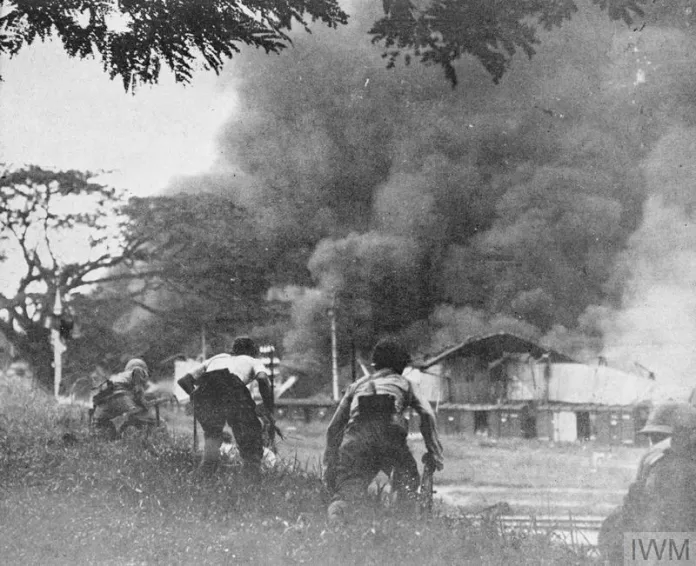Introduction
The Second World War was opened in Eastern and Southern Asia suddenly in early December 1941 by the Japanese. The British possessions in Hong Kong, Malaya, Borneo and Burma were overrun by the Japanese armed forces. In this article the Malaya Campaign, December 1941-February 1942 will be dis-cussed. The Indian, British and Australian forces had fought gallantly from the northern tip of Malaya down its spine to the island of Singapore. But most of the troops were untrained for jungle warfare. It is a tale of hasty retreat, encirclements and surrender, the forests and swamps making the prospect of escape grim and frequently impossible. It was one of the most humiliating defeats.
The Aim
The Malaya Campaign is of great interest for drawing lessons from for students of military history and is often critically discussed in military institutions of various countries. I was afforded a chance to visit some of the battle sites during my stay in Malaya-Singapore, 1946-Oct 1947, with my unit and as a junior staff officer with a formation of South East Asia Command.
A gist of the salient points of the Malaya Campaign is mentioned below:
The Terrain
The Malaya Peninsula separated from the Asian mainland is about 400 miles long and its width varies from 200 to 60 miles. On the west and south the Strait of Malays makes a long coast whereas in the east, the China Sea touches the mainland. On both sides there exist some important parts. An impassable jungle crowned mountain spine runs down the centre, restricting movement to the two coastal plains. The island of Singapore lies in its southern extremity separated from the mainland by the narrow strait of Johare. At the time of the campaign the western coastal plain had been partially developed, the eastern how-ever was largely uncultivated. West The main communications with Thailand ran along the west.
The border with Thailand had considerable strategic implications. In northern Malaya the main east-west coast communications were the road and railway line running from Jilra in northern Malaya to the port of Singora in eastern Thailand, and the road running from Kroh in northern Malaya to Patani in eastern Thailand.
The main production of Malaya was rubber, tine and iron. The population consisted of Chinese, Malayans, Indians and a large number of Japanese were also present as workers but some were spies. The Japanese had intimate knowledge of the defence installations, communication centers and location of military forces, and coastal defence system. The Japanese knew the classification of road and rail bridges. Taiping, Kota Bharu, Penang, 1poh, Kuala Lumpur, Kuala Selangre, Kuantan, Malacca, Ayer Hitam, Johar Bahru and Singapore were the important places. A few rivers existed but were fordable at various places.
Relative Strength
1) The British
During December1941 Lt Gen Percival was the Army Commander. He had been appointed GOC Malaya in April 1941, previously he had served in this theatre from 1936-38. In December 1941, the force available for the defence of Malaya consisted of the following:
1. 3rd Indian Corps
(Lt Gen Heath)
a. 9th Indian Division
(1) 8th Indian Brigade
(2) 22nd Indian Infantry Brigade
b. 11th Indian Infantry Division
(1) 6th Indian Infantry Brigade —2/16 Punjab Regt — now 14 Punjab (was under 6th Infantry Brigade), I commanded it during the September 1965 War.
(2) 15th Indian Infantry Brigade
c. Corps Reserve — 28th Indian Infantry Brigade
2. Indian Infantry Brigade.
3. 8th Australian Division —two brigades.
4. Singapore Fortress Troops
a. 1st Malayan Infantry Brigade
(1) 2nd Loyals
(2) 1st Malaya Regt
b. 2nd Malayan Infantry Brigade
Gen Percival had requested the war office that he would need at least six divisions with supporting troops (artillery, engineer and sup-ply, etc) to supplement his 2-1/2 weak divisions with about 26 battalions. He had 158 aircraft (most of them obsolete) whereas he needed 566 for the defence of Malaya. There was no armoured force, when the minimum requirement submitted was 2 tank regiments.
On the Island of Singapore the British had constructed what was widely regarded as the strongest naval base in the world — the Gibraltar of the Pacific. It was supposedly impregnable. £60000000 had been spent on its defences. The troops were untrained for jungle warfare. Replacement of losses, etc and reinforcements depended on arrival of ships from India and obviously caused delay and discontentment.
2) The Japanese
The Japanese had available for the invasion the 25th Army under Gen Yamashita (later called the tiger of Malaya). It comprised of 51n, 18th and the Imperial Guards Division and 3rd Tank Group con-sisting of four tank regiments. The standard Japanese division included a recce unit and two brigades each of two regiments each of three infantry battalions.
Therefore each division had 12 infantry battalions and a recce unit, as opposed to the nine infantry battalions organised in three infantry brigades of the Standard Indian infantry division. The total Japanese order of battle for the invasion totalled 125000 (a number of whom never landed) against an original British Army of about 80000. The dispersion of the British forces down the Peninsula gave the Japanese invaders the opportunity of defeating them in detail. The Japanese armour had played decisive role during offensive actions. The air support during the campaign was quick and overwhelming.
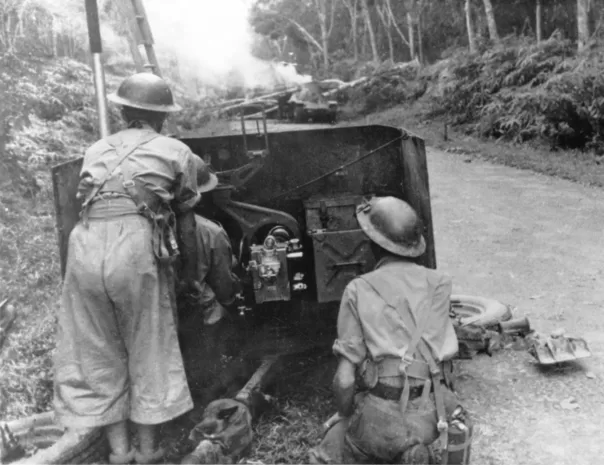
British Army Commander’s appreciation
It was correctly appreciated that owing to its undeveloped state a Japanese advance down the east coast would be difficult. The Thai ports of Singora and Patani offered access to the west. It was therefore expected that the Japanese plan to capture Singora and Patani, advance over to the west coast and then thrust south to Singapore. It was also appreciated that the offensive would be supported by a subsidiary operation to capture Kota Bahru and the adjacent airfields. There was also a possibility that the Japanese might attempt a landing in More, or even Singapore.
The Army commander kept the two Malaya Brigades in Singapore and the 12th Indian Brigade as a Force reserve. In Johore, 8th Australian Division was stationed. The role of defending Northern and Central Malaya was entrusted to 3rd Corps under command of Lt Gen Heath. The Corps Commander positioned 9th Division (of two brigade) to defend the east coast with 8th Brigade at Kota Bahru and 22nd Brigade at Kuantan, 150 miles to the south. In northern Malaya Gen Heath placed 11th Division and put his Corps reserve, 28th Brigade at Ipoh.
Based on the deductions of the relevant factors it was agreed that the best way to counter the over-land attack was to seal off the land approaches by capturing the port of Singora (Thailand) and holding the Singora-Patni (Thailand) on the east coast. Therefore Operation Matador was planned in which II Division by a lightning move was to seize the vital area. But the neutrality of Thailand was a great obstacle and Operation Matador became a victim of hesitancy and was never ordered.
If Matador was cancelled II Division had the task of defending the airfields at Alor Star and Sungei Patani. A defensive position at Jitra was selected and another to be prepared at Gurun to the south. It was also considered that the Japanese forces landing at Patani and advancing to the west coast would outflank both the Jitra and Gurun positions.
The Japanese army commander planned the invasion of Malaya as under:
a. 9th Infantry Brigade was to move down the Singora-Jitra road and capture Alor Star airfield.
b. 42nd Infantry Regiment was to advance on Kroh by Patana-Kroh road.
c. The divisional objectives were first the line of the Perah river and secondly, Kuala Lumpur.
d. The Imperial Guards Division was to over awe Thailand and then support 5th Division in its thrust down the west coast.
e. 56th Infantry Regiment was ordered to seize Kota Bahru and its airfields and then exploit southwards to Kuantan. Remainder of 18th Division was to be held in readiness to support the advance as necessary.
On 6th December, 1941 Japanese sea convoys were sighted by the British recee aircraft but it was not possible to know whether they were destined for Thailand or Malaya. Troops were brought to the highest degree of readiness. The C in C (Admiral Robert Brooke Popham) felt unable to order II Division to execute Operation Matador and cancelled it.
At about 1 a.m. on the 8th, a apanese landing was reported at Kota Bahru and early in the morning Japanese aircraft raided Singapore. The Japanese had landed at Singora.
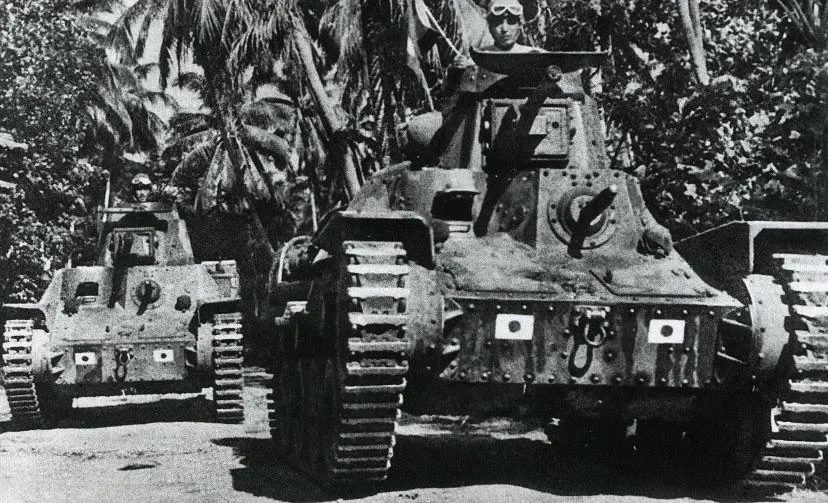
The battleship Prince of Wales (35000 ton) and the battle cruiser Repulse (32000 ton) alongwith four destroyers and some other escorting ships were sent for protection of Singapore base on 8 December. The mission was to smash the Japanese transporters and their troops before their landings in Malaya. The presence of the mighty naval ships in the Malaya Sea was a great morale booster for the troops and the population. The air cover for the naval ships was meager. When these ships were only 50 miles off the Malaya Coast and 150 miles from Singapore, the Japanese recce planes had spotted them. On 9th December the ships were attacked with consummate skill and determination. The ships were sunk and over a thousand soldiers lost in the sea. It was a catastrophe almost as shocking as that of Pearl Harbour. The news demoralized the troops and the population.
The Japanese progress had been very rapid and from 8 December 1941 to 7 January 1942 they had control of the entire Northern Malaya from Thailand border to the River Slim, a distance of about 200 miles covered in 31 days. During that period some tenacious battles were fought at Jitra, Kroh, Rengut, Kampar and the Perak River position. However the Japanese were successful due to their bold tactics of outflanking movement, infiltration, by passing of opposition and ambushing of reinforcement and supply convoys. Their jittering parties had often managed to force the defenders to fire all their weapons and expose their positions.
After the action on the Slim River on 7th January, 12th Brigade (force reserve) had virtually ceased to exist and the 28th Brigade (Corps reserve) had been reduced to a third of its original strength. Both the brigades had lost all the transport, guns, equipment and supplies. It was a major disaster, it resulted in the early abandonment of central Malaya and 11th Division had ceased to be an effective fighting force. On the very day of the disaster at the Slim River, Gen Wavell, the Supreme Commander arrived in Malaya to see the situation him-self. During shelling and straffing of the enemy aircraft he had safely landed, went forward to see the situation. In view of the swift Japanese victories it was decided to withdraw the remaining force from Central Malaya to the suit-able area north of Johore. It was planned to impose maximum delay on the advancing Japanese force and hold them in the north-ern Johore until sufficient reinforcements could arrive, so that a counter offensive could be launched. But the withdrawal continued and by 11th January, 1942 the entire area upto Malacca and Rampir was vacated. Throughout the operation the Japanese air force was in action against the defenders and also bombing important deep targets. The defenders had little air support.
It was decided to impose maxi-mum delay on the advancing Japanese and then hold northern Johore until arrival of reinforcements to initiate counter offensive. The Supreme Commander had agreed that 3rd Corps with the present low strength was unable to impose much delay. In the mean-time 45 Indian Brigade had reached Singapore, but the troops were young and untrained.
The Supreme Commander (Gen Wavell) had watched fighting from forward trenches. He was convinced that soon the fighting would be intense and bloody. During flying bullets, shelling and straffing by the enemy aircrafts he took off. He had left the major decision with the Army commander
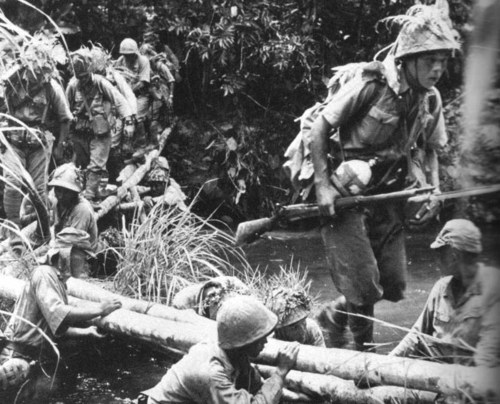
Relative Strength
The strength of the opposing forces on the even of the battle of Johore was as under:
Japanese Force — Imperial
Guard Division + 5th Division + 18th
Division+ Anti-Tank Battalion+8
Independent anti-tank companies +
3rd Tank Group consisting of medium and light tanks.
British Forces — 27th Australian
Brigade+8th Indian Infantry
Brigade+22nd Indian Infantry
Brigade+45th Indian Infantry
Brigade+28 Indian Infantry
Brigade+15th Indian Infantry
Brigade+22 Australian Brigade+two Malayan battalions+53 British Brigade. The British force had insufficient fire and air support. There were no tanks.
The British force was deployed on Jasin-Muar-Bakri axis, in Gemas, Batu Anan and Segmat areas. A strong force was deployed ahead of the river Maur. The formations (brigades) of the 3rd Indian Corps were deployed from Ayer Hitam to Young Peng and Batu Pahat including Endau and Mersing. Gaps were covered with patrols and ambush parties.
At 1600 hours on 14 January a large Japanese force mounted on cycles was seen approaching in from of Gemas. Half the force was allowed to pass the ambush area and the bridge over the river was blown. The sudden action and fire of the defenders had inflicted several hundred casualties on the Japanese. Several tanks and vehicles were also destroyed. The artillery was unable to fire because the communication sys-tem had broken down. The Japanese had managed to out-flank a few defensive localities and crossed the river in small boats north of Gemas. The destroyed bridges were quickly repaired by the enemy. On 15th January the Japanese had attacked the position of Gemas with tanks and infantry.
On night 14/15 January, a strong Japanese force crossed the river Muar upstream of Muar town. The forward localities were out-flanked and forced to fall back on the southern bank of the river. By 15th evening the Japanese were firmly in control of the northern bank of the river Muar. On 16/17 night many enemy parties had crossed the river. Inspite of counter attacks on the morning of 17th the Japanese could not be driven back, the penetration had turned out to be on a bigger scale. The defenders had suffered lot of casualties and losses of weapons, etc. Fresh landings of the Japanese had been reported at the mouth of the river Muar. The battalion opposing this landing had also suffered heavily. Counter attack by a reserve unit had failed. Units were moved to counter Japanese infiltration and landings, but all was in vain. All troops in front of Segamat were withdrawn.
Withdrawal of troops had continued from 19 to 22 January but heavy casualties were suffered by most of the units and by the evening of 25th the situation had become worse. The entire Johore sector was evacuated. Lot of vehicles, arms, guns and equipment had been lost. Complete defeat for the British forces was imminent.
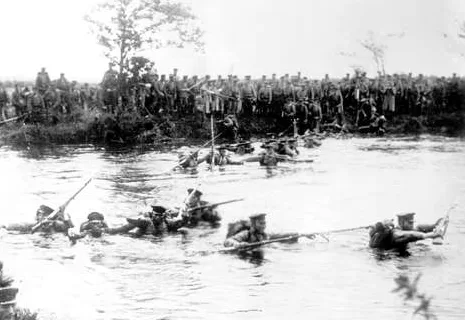
Surrender
“Defeat cries aloud for explana-tion whereas Success, like charity, covers a multitude of sins.” — (Mahan)
Between 29th January and 10th February,1942 most of the troops had moved to Singapore for the defence of the naval base. The Japanese had landed on the offshore islands of Singapore. Units and formations were assigned sectors for defence but were short of weapons and ammunition. In the afternoon of 8th February, the Japanese heavily shelled some important areas, the noise was the heaviest artillery fire of the war. The Japanese had infiltrated and sur-rounded many localities. On the 11th the Japanese C in C dropped by aeroplane a message for surrender but it was ignored and fighting went on. But then came the final blow. The Japanese had bridged the gap in the causeway connecting Singapore with the mainland, had passed tanks over it and on 14th seized the water reservoirs of Singapore. Capitulation now became unavoidable and it took place at 7 p.m. Singapore time on 12th February 1942. About 70000 troops (60000 were Indians) sur-rendered and thus ended the most disastrous campaign fought by the British forces. It took in a little over two months to achieve so astonishing a success. Unlike the great campaign fought in the West in which grand tactics dominated, the Japanese Malaya campaign was a triumph of minor tactics. The Japanese soldier was tough, well trained, lived on simple food of the land and was able to move with speed through difficult terrains.
Some reasons for the defeat are being mentioned below:
1. Lack of knowledge of the terrain by most of the commanders and troops;
2. Lack of training for jungle war-fare and bold use of minor tactics was ignored;
3. Presence of spies and enemy agents close to the British positions, gun areas, supply and communication centers;
4. Lack of air support, most of the aircraft (mostly old machines) had been destroyed within few days of the start of war. Lack of tanks and anti-tank weapons;
5. Most of the senior commanders had no first hand experience of Japanese methods of outflanking movement and infiltration;
6. Deployment of formations (brigade and division) lacked coordination which created wide gaps;
7. The British intelligence had failed to counter the activities of enemy spies and agents;
8. The Malaya command had sufficient troops to defend the Malaya Peninsula but nowhere any determined stand was made to blunt the Japanese advance. There were numerous acts of valour at unit level and the Japanese were made to suffer a lot of casualties;
9. The British rushed in some reinforcements, which arrived in time to share the defeat with the garrison. The reinforcements, weapons and ammunition were brought from the bases located a few thousand miles away.
Creation of Indian National Army (INA)
INA was the product and conse-quence of the British and American defeat in South East Asia in 1942. The Japanese were aware of Indian nationalism and had decided to exploit for politico-military purposes their Indian prisoners of war. Capt Mohan Singh of 1/14 Punjab (now 5 Punjab) an lndianised Battalion was captured in North Malaya (JITRA) in December 1941 and found in him a suitable instrument of figurehead. He was put in command of all the Indian prisoners of war and were persuaded to join INA which they were told, would go forward along-side its Japanese allies and liber-ate India from British yoke.
Out of about 60000 Indian troops who surrendered to the Japanese in February 1942 in Singapore, nearly 25000 were enticed to join INA raised under the tutelage of Japanese. Capt Mohan Singh soon fell out with the Japanese because they had failed to fulfill the lavish promises made for the INA troops. He severed his contacts and a few thousand Indian troops also went with him to prisoner of war camps. Thus temporarily the activities of INA remained suspended. But on 21 October 1943, Subhas Chandra Bose with the agreement of the Japanese proclaimed the Provisional Government of Azad Hind with himself as the head of the State and C in C of the INA. Due to the leadership of Bose, his fiery oration and promises, some fresh volunteers and some from the Indian civilian community in Malaya and Singapore had joined the INA. Its strength had reached nearly 60000. Some Indian officers and VCOs also joined and were granted 3 to 4 upwards (Lieut to Col and even VCOs and NCOs were granted commission as Lieut, Captain and even Major).
The INA troops were mostly armed with captured weapons, but replenishment was negligible. Also ration and supplies were not according to the scale. During the Japanese offensive in 1944 in Arakan, Kohima, Ukhrul and Imphal INA troops also participated in great numbers. In the beginning the INA troops were confident of victory, however as the families of most of them were living in India, they were afraid of reprisals against them by the British Indian Government. Whenever an opportunity was found the INA troops easily sur-rendered and volunteered to pro-vide useful information of tactical nature and the Japanese losses. During some battles my Company encountered INA troops, most of them surrendered and provided information about location of Japanese units, their losses and critical supply situation and replenishment system.
The crushing Japanese defeats in Arakan, Kohima, Imphal and Meiktila had adversely affected the morale of the INA troops. Most of them could read the ultimate defeat written on the wall. With the final defeat of the Japanese the INA also perished, but the trial of some officers is an interesting but rather long episode, and will be highlighted in a separate article.♦
Bibliography
1. The War against Japan —Maj Gen Woodburn Kirby
2. The War — A concise History 1939-1945 — Louis L. Synder
3. The Second World War, 1939-1945 — Maj Gen J.F.C. Fuller
4. Solah Punjab, History of the 16th Punjab Regt — Lt Col J.P. Lawford & Maj WE Catto
Auchinleck, Field Marshal —John Connell
Many more books


